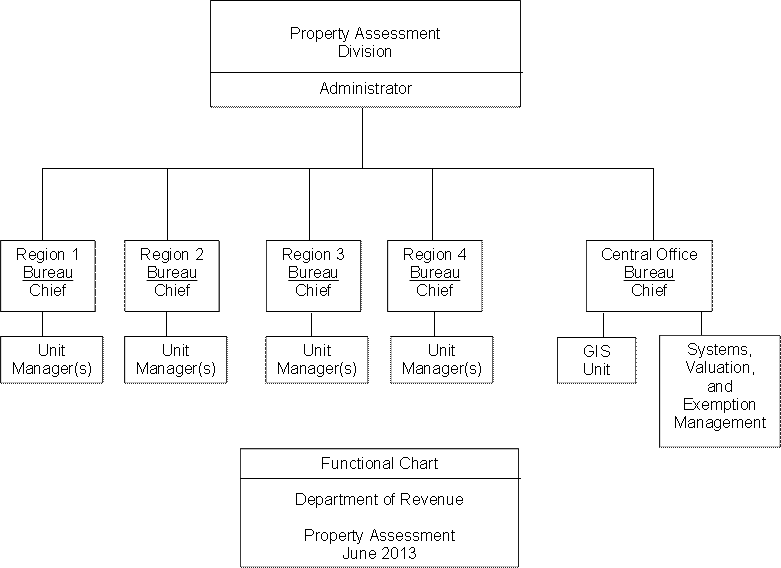
| HOME | SEARCH | ABOUT US | CONTACT US | HELP | ||
| |
| This is an obsolete version of the rule. Please click on the rule number to view the current version. |
|
42.1.101 ORGANIZATIONAL RULE (1) Organization of department. (2) History. The Department of Revenue was implemented under the Executive Reorganization Act of 1971 by executive order of the Governor on August 9, 1971. See 2-15-1301, MCA. (3) Divisions. An administrator heads all divisions of the Department of Revenue. The Department of Revenue is composed of five divisions listed below: (a) Business and Income Taxes Division; (b) Citizen Services and Resource Management Division; (c) Information Management and Technology Division; (d) Liquor Control Division; and (e) Property Assessment Division. (4) Director. The Director of Revenue is the head of the Department of Revenue. The director is appointed by, and serves at the pleasure of the Governor as provided in 2-15-1302, MCA. The director is the Chief Administrative Officer of the department. The director is responsible for faithfully executing the laws and programs delegated to the department within the resources and authority assigned to it. The director has authority over all activities and all employees of the department. (5) The Director's Office. The Director's Office seeks to ensure that the department, in administering the law, respects the dignity of every citizen, upholds and advances the integrity and equity of the tax system, and continually improves productivity and teamwork. The office is composed of the following sections that perform the basic functions as described: (a) The executive office is responsible for the general management and guidance of the agency. This office assists the director with administrative functions and communications to the public, Montana officials and agencies, local subdivisions and schools, the federal government, tribal governments, and the governments of other states. (b) The Office of Taxpayer Assistance, established pursuant to 15-1-223, MCA, is responsible for providing assistance and resolution to taxpayer issues and concerns, providing information on tax review and appeals processes, evaluating citizen complaints concerning department actions and procedures, assessing the department’s compliance with the Taxpayer Bill of Rights, and recommending improvements to the department’s services to citizens. (c) The Legal Services Office is responsible for the overall legal efforts of the department, which include: legal representation before various state and federal courts and legislative development. It is responsible for the management of the Regulatory Unit, which handles taxpayer inquiries from other taxing jurisdictions, state agencies, and private citizens; serves as the information security and disclosure manager; and oversees the department's rules and procedure developments. The legal services office further oversees the Office of Dispute Resolution. (d) The Office of Dispute Resolution, established pursuant to 15-1-211, MCA, reviews, facilitates, and resolves taxpayer disputes internally through a variety of means, including mediation. (e) The Tax Policy and Research Office is responsible for preparing legislative fiscal notes that affect revenue, analyzing legislative proposals affecting the department, conducting economic, public finance, tax compliance and operations research, and assisting the department in administering functions that require data analysis. (f) The Human Resources and Organizational Development Office is responsible for providing human resources support services, conducting the department’s recruitment, labor relations, and performance appraisal processes, assisting with disciplinary actions and procedures, developing department policies, maintaining payroll and benefits functions, and providing a continuing education program to support employee performance. (g) The Public Information unit responds to requests from the public and the media, coordinates the department’s web site and other electronic communications, writes and/or edits department documents, rule notice language, instructions and communications for effective understanding by the public, other officials and agencies and department staff, and provides training and support for continuing improvements in the department’s communications. (h) The Budget Management office prepares and explains budget requests and documents, coordinates the administration of the department’s budget, recommends budget actions, productivity measures and priorities, and assists in explaining the department’s budget to executive and legislative officials. (6) Advisory Committees. Two advisory committees are attached to the department. The Agricultural Land Valuation Advisory Committee, with members appointed by the Governor, was created by 15-7-202, MCA, and the Forest Lands Taxation Advisory Committee, with members appointed by the Governor and legislative leaders, was created under the authority of 15-44-103, MCA. These committees have no rulemaking or rule adjudicating authority. (7) Attached Board. The board of review, which oversees the one-stop licensing program, as established in 30-16-302, MCA, is attached to the department for administrative purposes only. The board has separate rulemaking authority under 30-16-104, MCA. (8) Functions of Department Divisions. The basic functions of the various divisions are as follows: (a) Business and Income Taxes Division. The Business and Income Taxes Division is responsible for ensuring equitable compliance with the nearly forty state-collected Montana taxes assigned to the department. Examples of these taxes include but are not limited to individual income, corporation license, natural resource, withholding, selected sales and excise taxes, and other miscellaneous taxes. The division equitably values industrial and centrally assessed property and transmits those values to the Property Assessment Division. The division also manages the state’s participation in the cooperative federal mineral royalty auditing program and administers abandoned property (except for distributions to citizens), escheated estates and unlocatable mineral trusts. Further, it administers a set of non-revenue functions related to utility and tobacco regulation. The division administers these functions through the Income and Withholding Tax Bureau and the Business Tax and Valuation Bureau. (b) Citizen Services and Resource Management Division. The Citizen Services and Resource Management Division provides services to support the productivity and effectiveness of the department to achieve equitable compliance by properly accounting for taxes and other funds due, and offers services that help taxpayers voluntarily comply with tax laws. The Financial and Asset Management Bureau ensures state tax revenues and department expenses are properly accounted for. The bureau also distributes those revenues among public accounts. This bureau further supports department operations statewide by managing facilities and conducting safety, disaster preparedness, and continuity of government functions. The Collections Bureau collects accounts receivables for taxes and also for debts owed to other agencies and manages the bankruptcy program. The Citizens Services Bureau responds to citizen questions through the call center, designs forms and instructions to aid taxpayer compliance, coordinates small business licensing for multiple agencies, and distributes abandoned property to its rightful owners. (c) Information Management and Technology Division. The Information Management and Technology Division supports continuing improvements in department operations by providing effective management of taxpayer information and by developing and maintaining cost effective technological services. The Information Management Bureau processes tax information, returns and payments, ensures the security of that information, and produces usable tax data to support the goals and objectives of the department. The Information Technology Bureau develops and supports technology applications and equipment, maintains the effectiveness, usability, and security of department computer networks, and supports communications systems linking department operations together. (d) Liquor Control Division. The Liquor Control Division is responsible for administering the Alcoholic Beverage Code with an emphasis on excellence in customer service and a focus on public safety by ensuring a safe, orderly, and regulated system for the convenient distribution and responsible consumption of alcoholic beverages. The division also collects alcoholic beverage taxes. The division consists of the Liquor Distribution Bureau, which oversees the warehousing, inventory, and shipping of distilled spirits and fortified wines and the state agency liquor stores unit that manages the exclusive retail operation of liquor and fortified wines, and the Liquor Licensing Bureau that oversees the licensing of on-premises and off-premises businesses, manufacturers, wholesalers, warehouses, importers, and liquor representatives. The division, through an education staff, administers Montana's responsible server training law and provides information to protect public health and safety. The division's internal controls staff provides for the proper accounting of liquor taxes, transactions, and funds. (e) Property Assessment Division. The Property Assessment Division is responsible for the equitable valuation and assessment of real and personal property throughout the state for property tax purposes and for the administration of the property tax laws, including exemptions. The division supervises Montana's property tax system, tracks the changes in local taxing jurisdictions, certifies official values for all such jurisdictions and provides information that enables county treasurers to bill and collect property taxes. The division is composed of two primary sections. The basic function for each of these sections is: (i) The central office is responsible for the general management of the division. This office consists of the Administrator, Bureau Chief, Geographic Information System Unit, and Management Analysts who provide services to citizens and administrative and technical support to the local county offices. The central office also maintains the statewide property tax records and the publicly available cadastral web site. (ii) The field offices are arranged into four geographically distinct regions which encompass all 56 local county offices. Each region is managed by a Regional Manager and several Area Managers. The local county offices consist of appraisers and property valuation specialists who provide customer service and assistance to the public, perform property reviews, appraisals and assessments, and update property tax records. (9) Information and Submissions. General inquiries regarding the department may be addressed to the Director of Revenue. Specific inquiries regarding the functions of divisions may be addressed to the division administrator. All requests for hearings, declaratory rulings, and for the participation in rulemaking activities may be addressed to the director's office unless the notice in the Montana Administrative Register provides otherwise. (10) Office Locations. Addresses for the director and divisions are as follows: The Director's Office, Room 455, Sam W. Mitchell Building, P.O. Box 5805, Helena, Montana 59604-5805. Legal Services Office, Room 455, Sam W. Mitchell Building, P.O. Box 7701, Helena, Montana 59604-7701. Business and Income Taxes Division, Sam W. Mitchell Building, P.O. Box 5805, Helena, Montana 59604-5805. Citizens Services and Resource Management Division, Sam W. Mitchell Building, P.O. Box 5805, Helena, Montana 59604-5805. Information Technology and Processing Division, Donovan Building, P.O. Box 5805, Helena, Montana 59604-5805. Liquor Control Division, 2517 Airport Road, P.O. Box 1712, Helena, Montana 59624-1712. Property Assessment Division, Central Office, Sam W. Mitchell Building, P.O. Box 8018, Helena, Montana 59604-8018. Property Assessment Division, region 1, Kalispell, Montana 59901. Property Assessment Division, region 2, Great Falls, Montana 59401. Property Assessment Division, region 3, Billings, Montana 59101. Property Assessment Division, region 4, Helena, Montana 59601. (11) Charts of Agency Organization. Descriptive charts of the Department of Revenue follow.
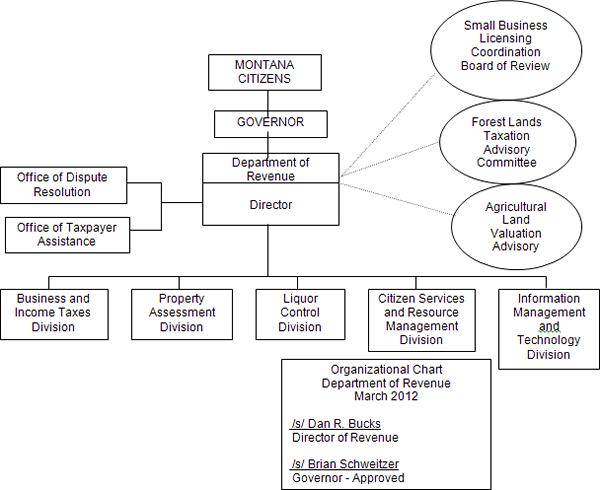 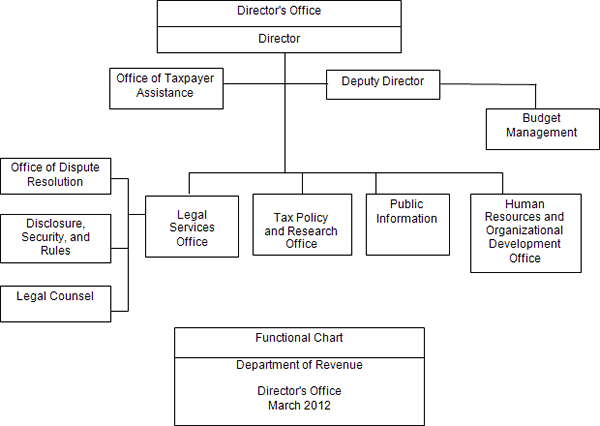 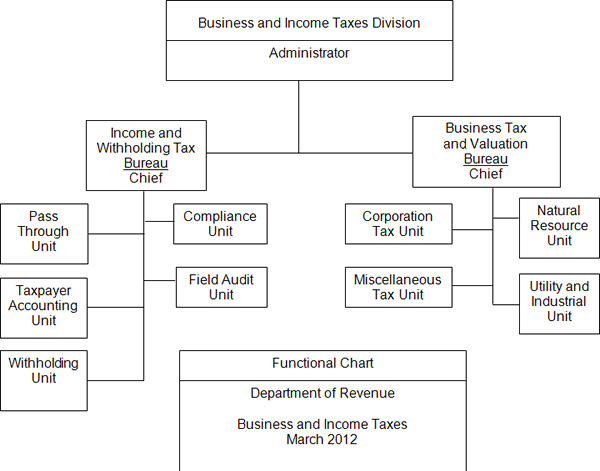 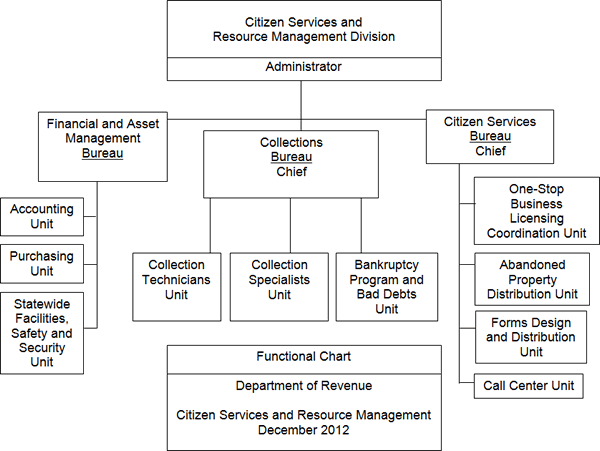
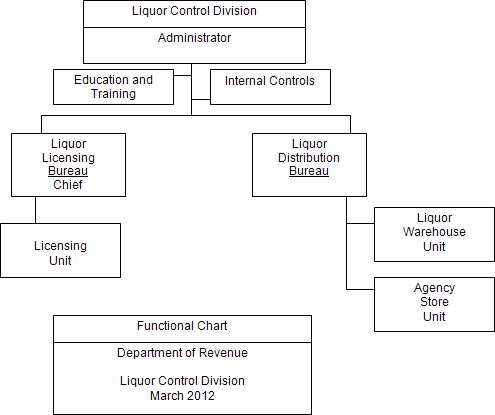
History: 2-15-1301, 2-15-1311, MCA; Eff. 12/31/72; AMD, Eff. 11/5/73; AMD, Eff. 8/5/74; AMD, Eff. 10/5/75; AMD, Eff. 1/2/77; AMD, Eff. 7/1/80; AMD, Eff. 7/1/81; AMD, Eff. 3/31/82; AMD, Eff. 4/30/86; AMD, Eff. 12/31/89; AMD, Eff. 9/30/91; AMD, Eff. 9/30/93; AMD, Eff. 6/30/98; AMD, Eff. 12/31/98; AMD, Eff. 12/31/01; AMD, Eff. 12/31/02; AMD, Eff. 9/30/03; AMD, Eff. 12/31/03; AMD, Eff. 3/31/04; AMD, Eff. 12/31/04; AMD, Eff. 3/31/06; AMD, Eff. 3/31/08; AMD, Eff. 9/30/10; AMD, Eff. 3/31/12; AMD, Eff. 9/30/13. |
A directory of state agencies is available online at http://www.mt.gov/govt/agencylisting.asp.
For questions about the organization of the ARM or this web site, contact sosarm@mt.gov.
